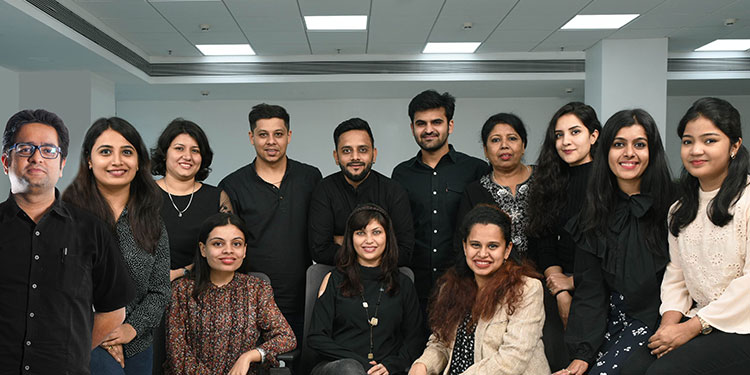ABND is a decade-old company founded with an idea and a vision to create an impact in the Branding industry.
While the initial focus remained on design capabilities and branding as a service, late 2017-2018 marked a change, and the company’s motto – ‘branding right for business growth’ came into being.
While most organizations talk of business and brand in the same breath, ABND decided to walk the talk with a focus on the small and medium enterprises. These included both B2B and consumer-facing brands. At that time, the company created fresh frameworks and processes that would enable the team to craft solutions for real business impact.

“It was tough when proposed, but we decided to keep at it. Not only the processes of brand building and brand management were re-hauled, but even the internal business practices at ABND were finetuned. This included keeping a focus on the bottom line and cash flow. Today, in 2020, no one can deny the importance of this as a business practice. Coming to clients, we saw our focus becoming sharper, our deliverables were more oriented to give them business results and we did award-winning work in the last 2-2½ years,” says Kunal Vora, Founder / Partner.
Maulik Chandarana, who was then consulting the organization, was a big proponent of this change. With a decade of experience in the industry, today, as the Head of Strategy and Business, Maulik continues on the same mission. “As Kunal said, it had its challenges. In fact, Kunal and I had differences too. But he let me handle things in my way. What is remarkable is, we agreed that developing anything needs time to nurture. While the end result may not be guaranteed, risk has the aspect of a larger reward if it works. And that is what we believed. My main concern became creating a culture that broke the traditional silos between designers and strategists. It means making the team members realize the brand building is ‘not’ a job that one delivers a component asked of – like a logo, or a label or a leaflet. In fact, ‘beyond the logo’ became an organizational goal. It’s not that magic happened instantaneously. There were heartburns too. But today, we are again at the tip of another change. And that’s exciting.”

What Maulik speaks of is the mission that ABND has taken up – to try and sensitize the industry as a whole to become a unified band of ‘brand practitioners’. Ekta Banodkar, Head of Design at ABND, says, “If this idea was floated earlier, I would have scoffed. But I have seen it in action when teams work together. Business is the bigger platform we are serving. As firms in the branding space, we need to realize that brands are at the service of the business. I don’t say short-termism is entirely wrong – sometimes, clients want, and may need only a list of deliverables – but a wide-view of business helps. Partnerships are fostered by seeing branding as a practice. The businesses see getting returns from the work and there is a sense of real contribution from the agency end.”
So, is Brand Practice something new? How is it unique? Maulik weighs in. “It may or may not be new. But if design teams, service teams, and strategy teams break silos, while their skill sets remain the same, they feel that they are part of a larger domain and importantly, they see their contributions. That is important, both, for agencies and clients.”

“I have seen people in the branding field struggle to explain what they do to outsiders. The nature of the industry to this extent is that people feel we are into design or advertising. The ambiguity leads people within and outside the industry, including clients, to compare brand consultancies to design shops or advertising agencies. The onset of digital is again seeing us being asked ‘do you offer social media?’ The importance of brand thinking in helping a business holistically, becomes a challenge to clients,” opines Maghan Varkey, senior brand strategist at ABND.
Clearly, there is a problem. How do you communicate value? How do you say that you offer growth paths via advisory and design combined?
“That is where brand practice comes in,” says Maghan. “As a firm, we must speak a common language. For example, we need to understand differences between visual architecture or a product portfolio, positioning should not be seen as a mere bunch of words by those who design, design should not be multiple options after the strategy is established. There’s so much to address about how the strategy operates, not in a deck as complicated frameworks and heavy jargons, but at a design level, at a pricing level, at a customer experience level, in a competitive environment, and much more. The concept of practice will bring harmony and mutual respect among professionals with different skillsets. And ultimately, it will be the client who will benefit,” adds Maghan.
So, what are the plans at ABND? Vora gives a download. “While we roll out ‘brand practice’ within the firm as per our objectives, we are spreading the word within the industry – both the agency-side and the client-end. At the client-end, since we cater to the B2B industry at a larger scale, the playbook is different, and this becomes important. Also, we see that branding professionals seek big and known consumer brands on their portfolio. The glamour quotient is absent in B2B brands but there can be the satisfaction of honing them as businesses using brand thinking. We’d like our culture of ‘brand practice’ to encourage that. We realize that Brand Building is a collaborative effort and cannot function in isolation. Hence, we’re developing new frameworks and models internally, to align brand thinking with the business and its bottom line. Additionally,we want brand practice to become known at various forums, publications and other platforms. We’d like to see a breed of brand practitioners come in who really see Brand and Business, and not elements like design, copy, advertisement, film or the likes.”
As a consulting firm, the onus is to re-invent and re-orient to serve clients. ABND is doing just that. Their repertoire of clients may not be the most well-known to the masses, but yet are names to reckon with. To booth, there is work, results, and some recent wins that speak. Their vision for the branding field is laudable. But clearly, the tussle between day-to-day work demands and building an organization with their vision will call for balance and high effort.
“Indeed,” agrees on Maulik and says, “The tussle and struggle are real. And I will sound idealistic – but we need a bunch of dreamers for real change. The branding field is small. Our country could well do with the industry having some names in the field – especially, the upcoming and mid-size firms – that can come together to define the future of ‘brand practice’. We could well break the delusion and confusion and complications existing. More so, we could be cultures where people really understand what they are doing and why they are doing it.” No wonder, he signs off on a positive note, “I don’t wish to see ‘people just on a job’ but I hold a vision of brand practitioners who exercise original thinking and express fearlessly.”
















